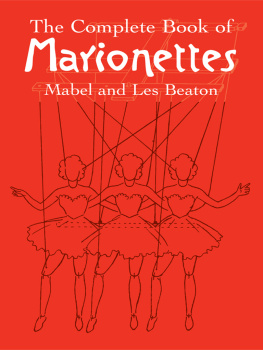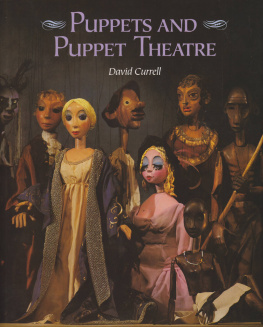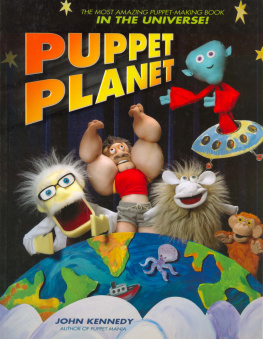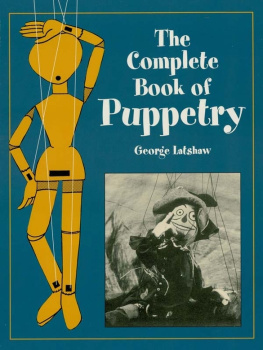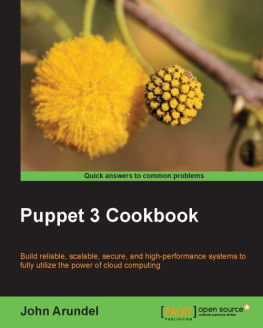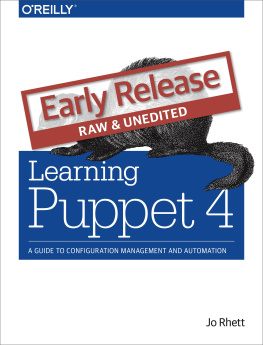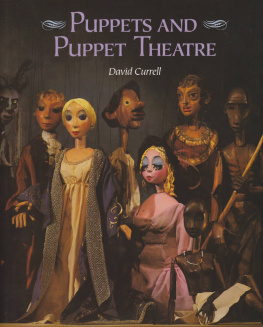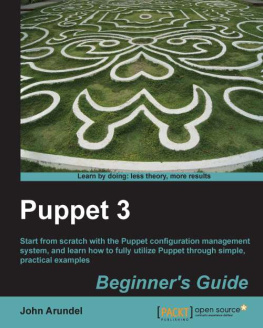The Complete Book of
Marionettes

The Complete Book of
Marionettes
Mabel and Les Beaton
Dover Publications, Inc.
Mineola, New York
Copyright
Copyright 1948, 1976 by Mabel and Les Beaton
All rights reserved.
Bibliographical Note
This Dover edition, first published in 2005, is an unabridged and slightly altered republication of the work originally published by Thomas Y. Crowell Company, New York, in 1948 under the title Marionettes: A Hobby for Everyone. The Dover edition adds a foreword by Gary Busk and an additional chapter by Paul Eide, both of which were previously published in a 1989 paperback reprint of the work by the Dallas Puppet Theater Press. The present edition also includes a final chapter about Mabel Beaton, written by Gary Busk, originally published in the Summer 2001 issue of The Puppetry Journal, and used by permission of The Puppeteers of America.
In addition, the pattern for the cloth-bodied marionette printed on the back of the dust jacket in the 1948 edition has been reproduced here on pp. xxiii. The original endpaper design has been reproduced on pp. viiiix.
Library of Congress Cataloging-in-Publication Data
Beaton, Mabel, 19052001.
The complete book of marionettes / Mabel and Les Beaton.
p. cm.
Rev. ed. of: Marionettes. 1948.
ISBN 0-486-44017-6 (pbk.)
1. Puppet theater. 2. Marionettes. I. Beaton, Leslie. II. Beaton, Mabel, 19052001. Marionettes. III. Title.
PN1972.B35 2005
791.53dc22
2005043055
Manufactured in the United States of America
Dover Publications, Inc., 31 East 2nd Street, Mineola, N.Y 11501
44017602
To the Peningo Puppeteers
each of whom had a hand in this book,
photographically or figuratively
Contents

ACKNOWLEDGMENTS. The authors wish to thank all the people who aided, abetted, and needled them into getting this book to the publisher and to those who by their enthusiastic support, personal effort, and donations of material things assisted the project that made this book possible; prominent among them Billy and Les Gillette, Bill Brown, Edythe Siedle, Corinna and Peggy Nesmith, Jane Karver, Charles Dean, Dr. James A. Tobey, Jerry Cook, Vee and Oddie Odquist, Bob Newell, Warren and Hughette Somerville, Georgiana Brown Harbeson and Frank Godwin, Gene and Helen Watson, Cass Saunders, Gladys Adams, Jane and John Ferguson, Marcia Dalphin, Rita Allen, Pru Devon, Della Alder, Gladys Boyce, Betty and Ed Richards, Charles Brower, Suzanne Alderman, Bliss Woodward, Bill Bijur; also the Third Twig of Rye, New York, and the various chairmen of Rye rummage sales who saved choice articles for the Peningo Puppeteers; and the puppeteers themselves, especially Bob Nesmith who contributed several of the group photographs, Dot Nesmith, Mimi and Mac McCabe and Alice and Phil Humphrey.
FOREWORD
The title of this book, Marionettes, a Hobby for Everyone, can be misleading.
When Les and Mabel Beaton wrote it they may have had the hobbyist in mind. But since its publication in 1948 it has been a book that puppeteers at all levelsamateur to professionalhave loved, respected and treasured.
Beautifully written, it makes the basics of construction and production easy to understand. Its use of photo layouts could stand as a model for any how-to-do-it book.
And many professional puppeteers started out with this book. They call themselves the Beaton Babies, and the book sometimes called the Beaton Bible.
When we first met Mabel in 1984, in Cape Cod where she lives now, she was a little surprised to learn how widespread is the respect for her book, even decades after it went out of print (about the mid-fifties).
Since then puppeteers and collectors have continued to search used bookstores for a copy they could own. But copies are hard to find and are also disappearing from libraries.
It seemed to be time to undertake the reprinting of this book, partly for the generations of puppeteers who never had their hands on a copy, but mostly out of affection for the book and its author.
Gary Busk,
Dallas, Texas
June 1989


Note: The patterns for the arm and body have been reproduced at 78% of original size.
Shoes should be cut from felt, soft leather, or oilcloth. Wrap top edge around foot, overlapping arounded edges at toe. Fold under sole at dotted line and overcast seams along bottoma of sole and at toe and heel.

Lay tissue paper or sections of old paper pattern over these patterns and trace them carefully. You will then have a good master pattern from which many puppet bodies can be made. Fold the muslin once before pinning the pattern to it so that each piece will be cut out in duplicate.
Photographs and detailed directions for stitching, stuffing and completing the cloth body are found in . A thorough study of this chapter before you begin your cloth marionette will be most helpful.
Note: The patterns for the shoes and legs have been reproduced at 78% of original size.
Original title of the present volume
1. Preface to Puppeteering
This is a book about marionettes, those beguiling little, animated puppet actors who create for us in miniature theaters of their own the comedy, the tragedy, and the fantasy of all time.
This is a chronicle of how marionettes are constructed and how they are made to perform according to the ideas of their human creators (and occasionally, according to inscrutable ideas of their own). It is also the story of a group of grown-up men and women who discovered puppets anew for themselves out of a world of tiresome, adult humdrum, and of the joy and youth and gaiety it brought into their lives and the lives of others.
This is the age-old story of Mr. Punch told over again for our own immediate time.
That marionettes can be puppets but that puppets are not necessarily marionettes is a curious contradiction of the puppet world; so let us hasten to clarify that old, but inevitable question, What is the difference between a puppet and a marionette?
The word puppet is commonly conceded to be a broad, general term, covering every type of moving image, usually of humans or animals, that is actuated by human effort for the purpose of play-acting and entertainment. Puppets may be made of cloth, wood, leather, paper, clay, wax, stone, or any of countless other such materials. Human control may be effected by rods, sticks, strings, or wires, singly or in combination, and even by the human hand inserted inside the figure; and the puppets so controlled or actuated may be known as rod puppets, push puppets, shadow puppets, hand puppets (Punch and Judy are familiar examples of these), and string marionettes. These are all puppets, representing the ones best known to modern usage. In modern times the one who animates or operates any of these is called a puppeteer
Next page
